Abstract
Texas Star-SR, an A- B+ mutant derived by nitrosoguanidine treatment from Vibrio cholerae El Tor Ogawa strain 3083, was fed to 68 volunteers as an oral vaccine in doses of 10(5) to 5 X 10(10) organisms with NaHCO3. Sixteen (24%) vaccinees experienced some loose stools (unrelated to vaccine dose), but in only one did the total stool volume exceed 1.0 liter. The vaccine strain was cultured from duodenal fluid of 35 of 46 (76%) persons who ingested doses of 10(8) organisms or greater. No A+ B+ toxinogenic revertants were found among 456 clinical isolates tested. Sixty-three vaccinees (93%) manifested seroconversions of vibriocidal antibody, whereas only 20 (29%) had significant rises in serum antitoxin titers. Paired intestinal fluids from 41 volunteers showed significant rises of secretory immunoglobulin A against lipopolysaccharide (29%), Ogawa outer membrane preparation (29%), and toxin (12%) antigens. In challenge studies with pathogenic V. cholerae El Tor Ogawa and El Tor Inaba, the attack rate in vaccinees (7 of 25) was significantly lower than in controls (18 of 25) (vaccine efficacy, 61%); furthermore, the diarrheal stool volume in vaccinees was significantly less than that in controls (P less than 0.01). Texas Star-SR served as a prototype to investigate the concept of immunoprophylaxis by means of attenuated strains as oral vaccines. These observations provide an invaluable background for planning future studies with newly developed attenuated strains prepared by recombinant DNA techniques.
Full text
PDF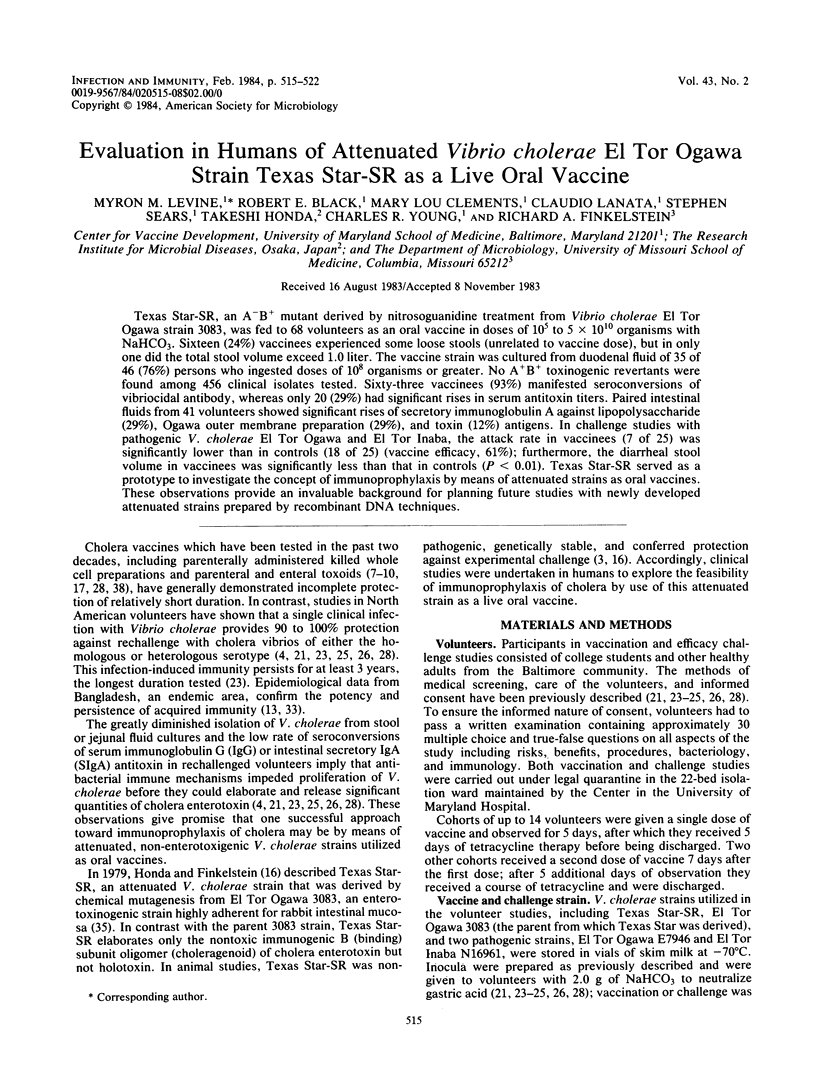
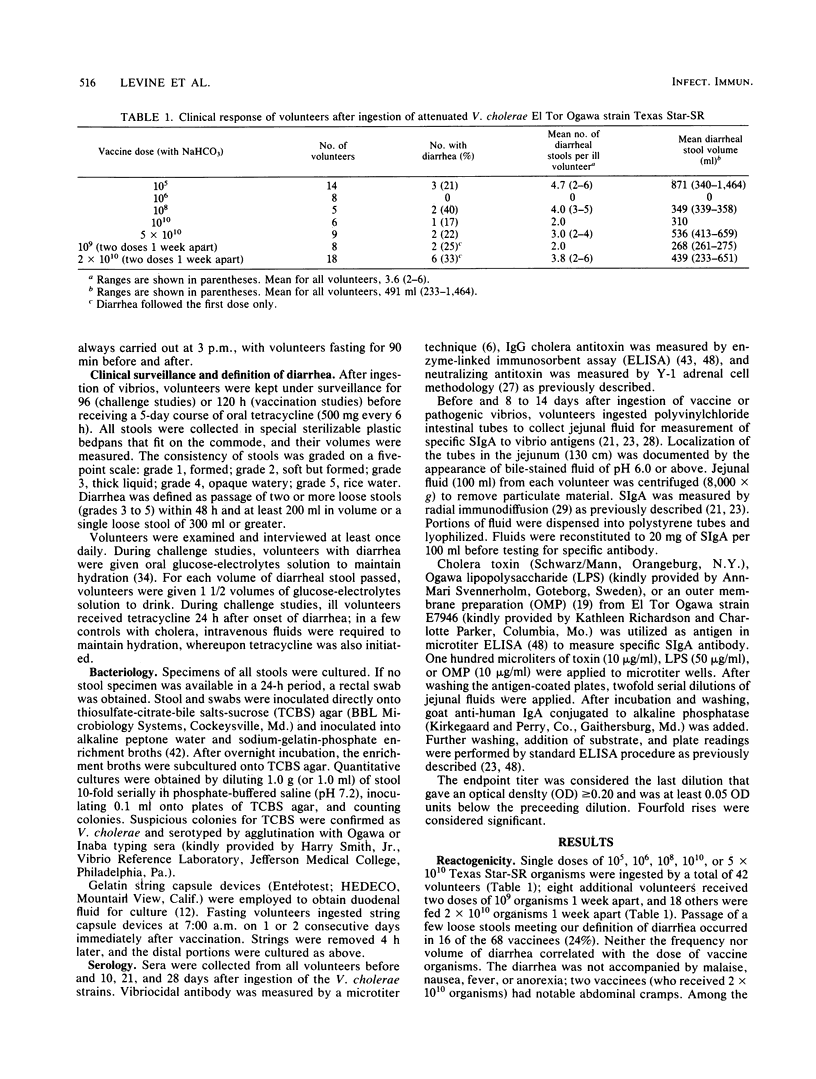
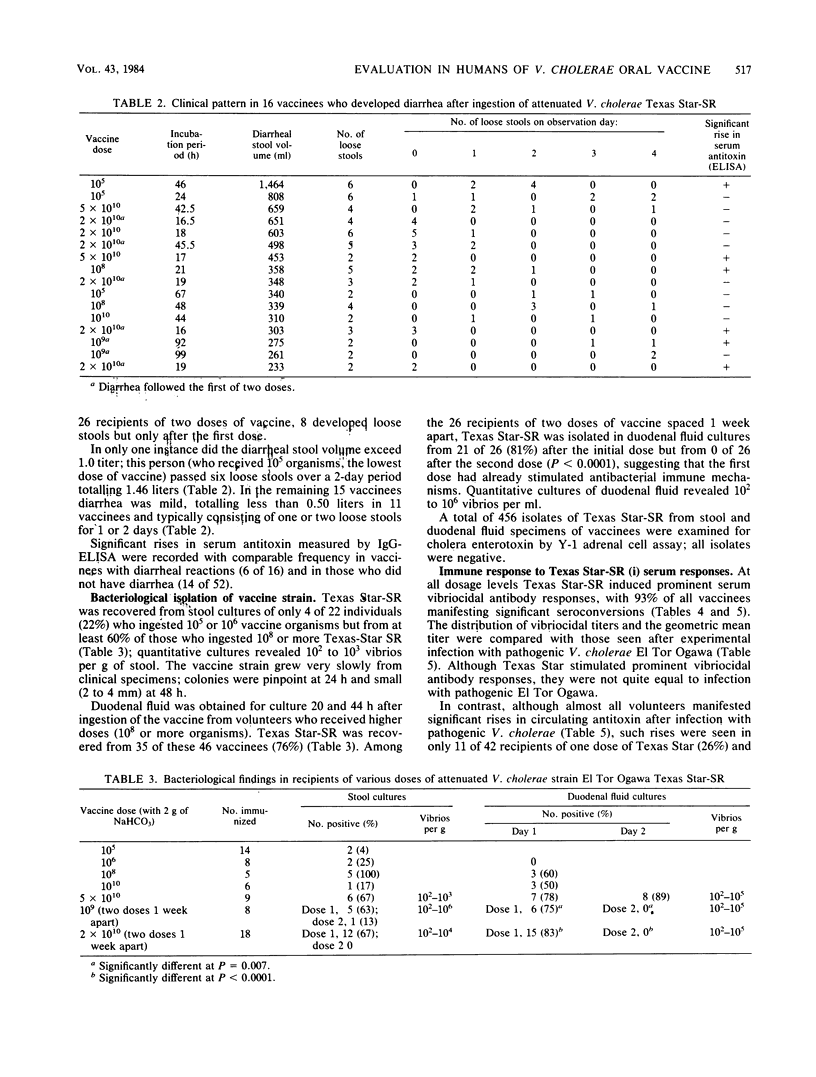
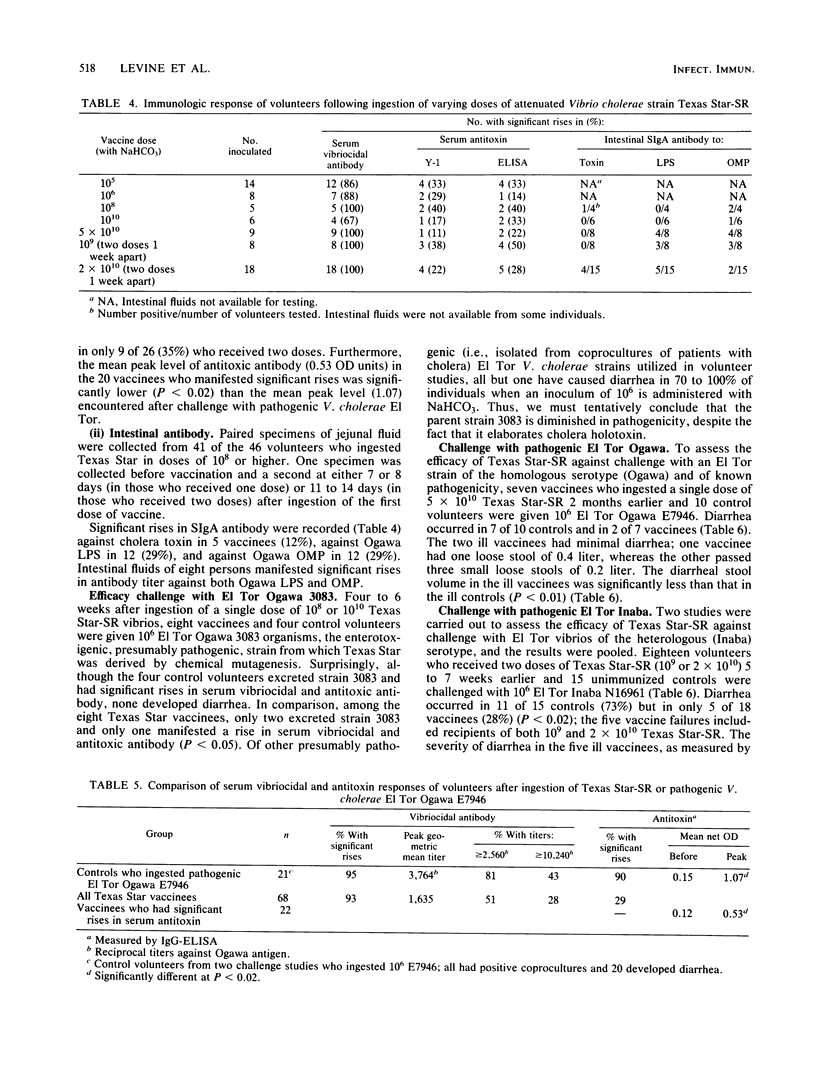
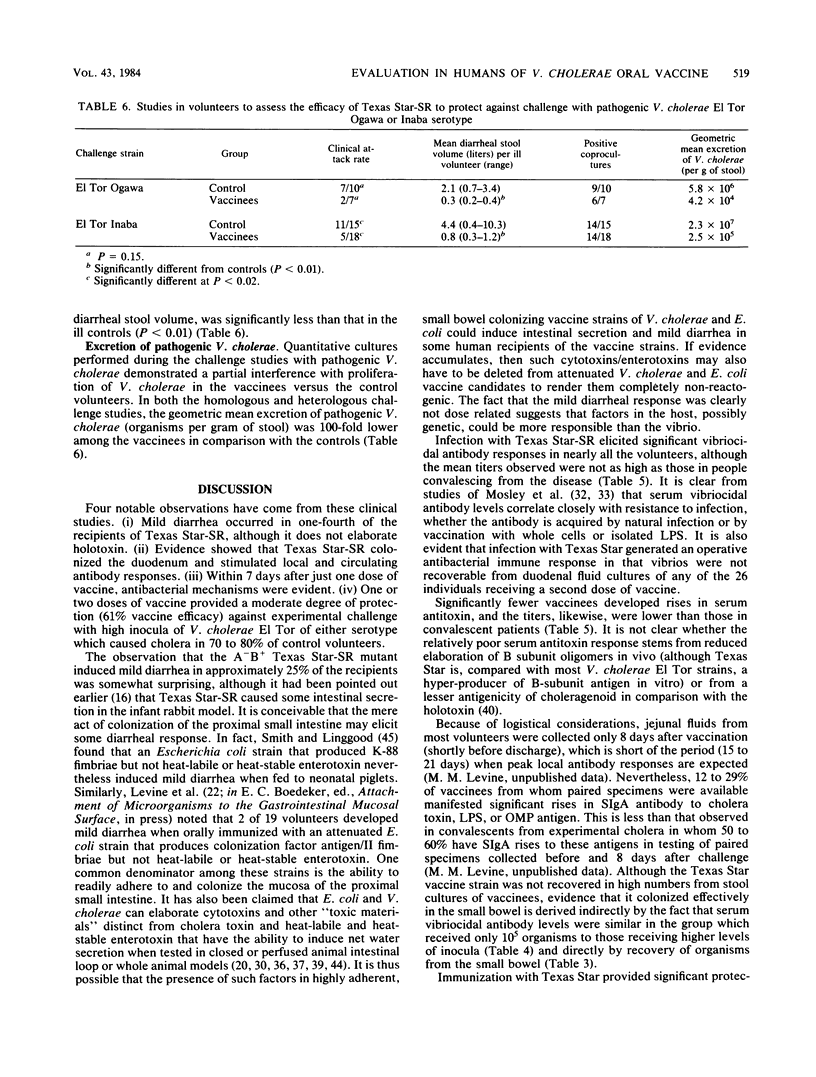
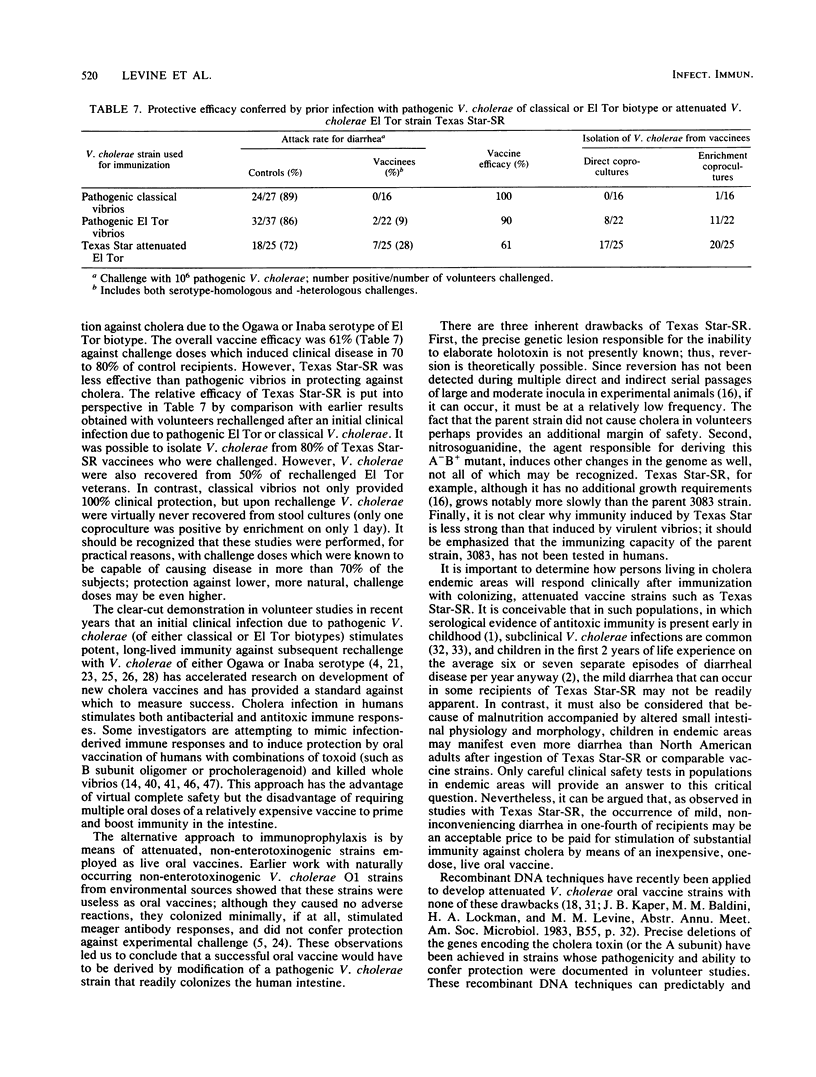
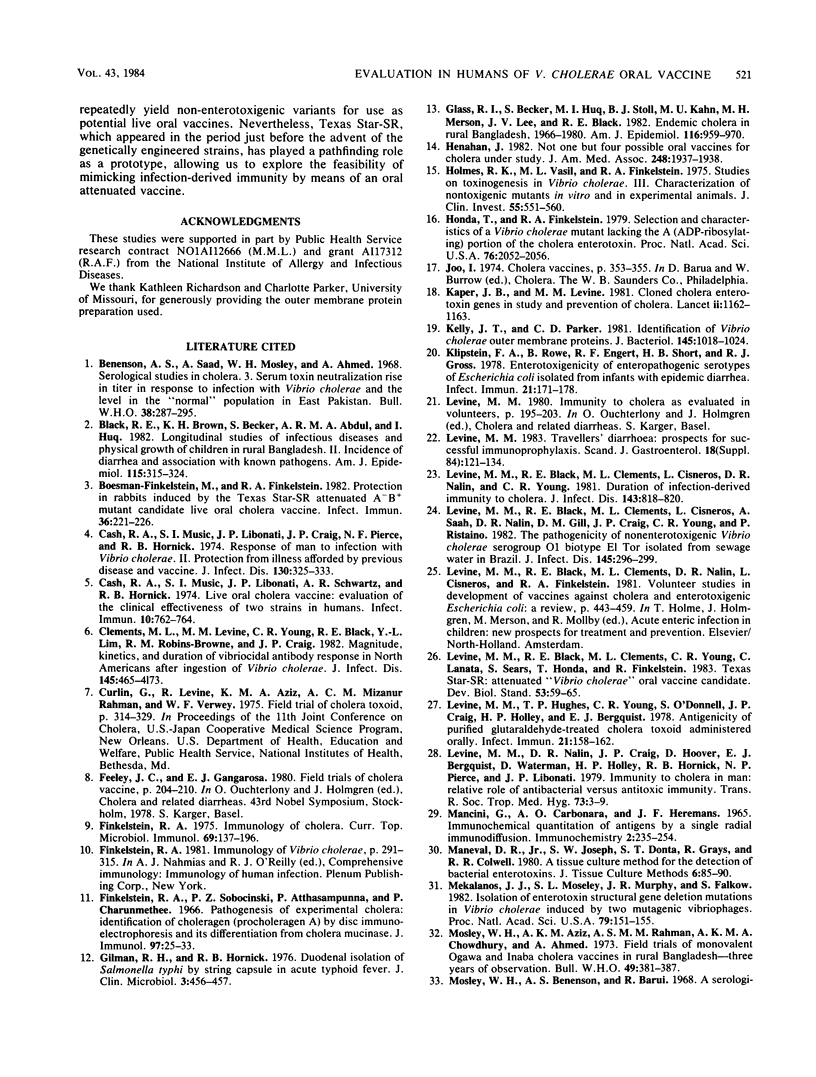
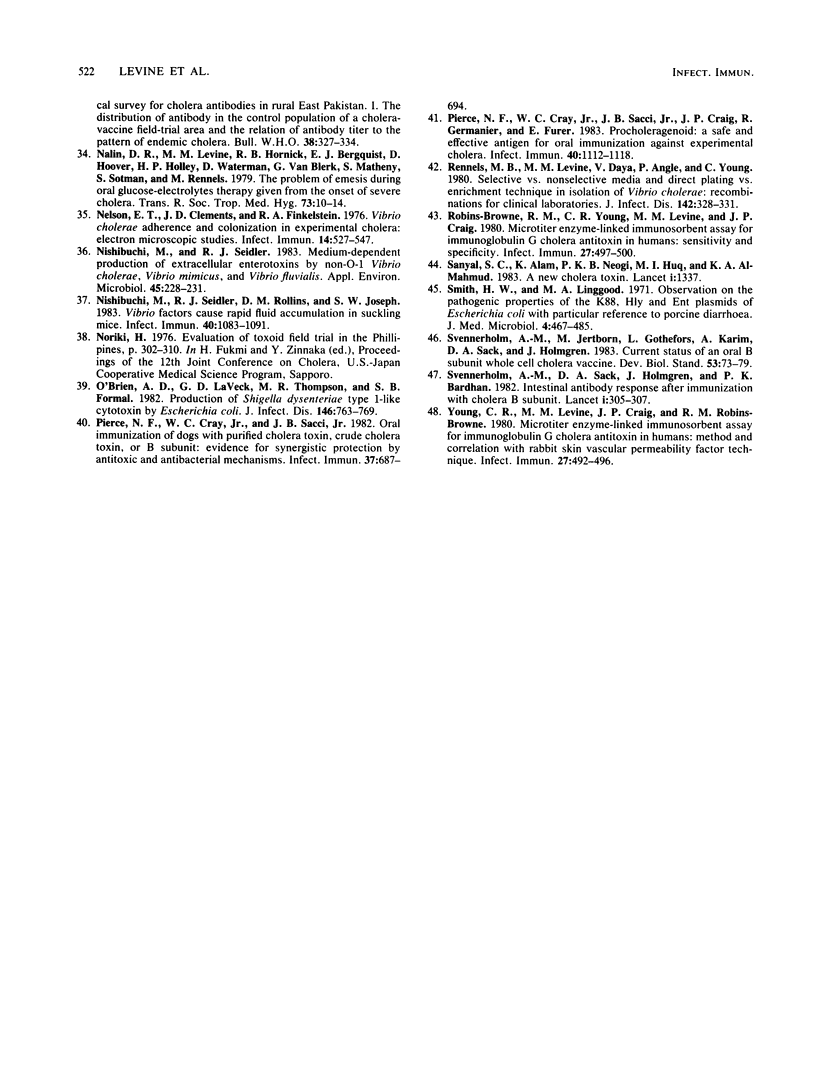
Selected References
These references are in PubMed. This may not be the complete list of references from this article.
- Benenson A. S., Saad A., Mosley W. H., Ahmed A. Serological studies in cholera. 3. Serum toxin neutralization--rise in titre in response to infection with Vibrio cholerae, and the level in the "normal" population of East Pakistan. Bull World Health Organ. 1968;38(2):287–295. [PMC free article] [PubMed] [Google Scholar]
- Black R. E., Brown K. H., Becker S., Alim A. R., Huq I. Longitudinal studies of infectious diseases and physical growth of children in rural Bangladesh. II. Incidence of diarrhea and association with known pathogens. Am J Epidemiol. 1982 Mar;115(3):315–324. doi: 10.1093/oxfordjournals.aje.a113308. [DOI] [PubMed] [Google Scholar]
- Boesman-Finkelstein M., Finkelstein R. A. Protection in rabbits induced by the Texas Star-SR attenuated A-B+ mutant candidate live oral cholera vaccine. Infect Immun. 1982 Apr;36(1):221–226. doi: 10.1128/iai.36.1.221-226.1982. [DOI] [PMC free article] [PubMed] [Google Scholar]
- Cash R. A., Music S. I., Libonati J. P., Craig J. P., Pierce N. F., Hornick R. B. Response of man to infection with Vibrio cholerae. II. Protection from illness afforded by previous disease and vaccine. J Infect Dis. 1974 Oct;130(4):325–333. doi: 10.1093/infdis/130.4.325. [DOI] [PubMed] [Google Scholar]
- Cash R. A., Music S. I., Libonati J. P., Schwartz A. R., Hornick R. B. Live oral cholera vaccine: evaluation of the clinical effectiveness of two strains in humans. Infect Immun. 1974 Oct;10(4):762–764. doi: 10.1128/iai.10.4.762-764.1974. [DOI] [PMC free article] [PubMed] [Google Scholar]
- Clements M. L., Levine M. M., Young C. R., Black R. E., Lim Y. L., Robins-Browne R. M., Craig J. P. Magnitude, kinetics, and duration of vibriocidal antibody responses in North Americans after ingestion of Vibrio cholerae. J Infect Dis. 1982 Apr;145(4):465–473. doi: 10.1093/infdis/145.4.465. [DOI] [PubMed] [Google Scholar]
- Finkelstein R. A. Immunology of cholera. Curr Top Microbiol Immunol. 1975;69:138–196. [PubMed] [Google Scholar]
- Finkelstein R. A., Sobocinski P. Z., Atthasampunna P., Charunmethee P. Pathogenesis of experimental cholera: identification of choleragen (procholeragen A) by disc immunoelectrophoresis and its differentiation from cholera mucinase. J Immunol. 1966 Jul;97(1):25–33. [PubMed] [Google Scholar]
- Gilman R. H., Hornick R. B. Duodenal isolation of Salmonella typhi by string capsule in acute typhoid fever. J Clin Microbiol. 1976 Apr;3(4):456–457. doi: 10.1128/jcm.3.4.456-457.1976. [DOI] [PMC free article] [PubMed] [Google Scholar]
- Glass R. I., Becker S., Huq M. I., Stoll B. J., Khan M. U., Merson M. H., Lee J. V., Black R. E. Endemic cholera in rural Bangladesh, 1966-1980. Am J Epidemiol. 1982 Dec;116(6):959–970. doi: 10.1093/oxfordjournals.aje.a113498. [DOI] [PubMed] [Google Scholar]
- Henahan J. Not one but four possible oral vaccines for cholera under study. JAMA. 1982 Oct 22;248(16):1937–1938. doi: 10.1001/jama.248.16.1937. [DOI] [PubMed] [Google Scholar]
- Holmes R. K., Vasil M. L., Finkelstein R. A. Studies on toxinogenesis in Vibrio cholerae. III. Characterization of nontoxinogenic mutants in vitro and in experimental animals. J Clin Invest. 1975 Mar;55(3):551–560. doi: 10.1172/JCI107962. [DOI] [PMC free article] [PubMed] [Google Scholar]
- Honda T., Finkelstein R. A. Selection and characteristics of a Vibrio cholerae mutant lacking the A (ADP-ribosylating) portion of the cholera enterotoxin. Proc Natl Acad Sci U S A. 1979 Apr;76(4):2052–2056. doi: 10.1073/pnas.76.4.2052. [DOI] [PMC free article] [PubMed] [Google Scholar]
- Kaper J. B., Levine M. M. Cloned cholera enterotoxin genes in study and prevention of cholera. Lancet. 1981 Nov 21;2(8256):1162–1163. doi: 10.1016/s0140-6736(81)90605-x. [DOI] [PubMed] [Google Scholar]
- Kelley J. T., Parker C. D. Identification and preliminary characterization of Vibrio cholerae outer membrane proteins. J Bacteriol. 1981 Feb;145(2):1018–1024. doi: 10.1128/jb.145.2.1018-1024.1981. [DOI] [PMC free article] [PubMed] [Google Scholar]
- Klipstein F. A., Rowe B., Engert R. F., Short H. B., Gross R. J. Enterotoxigenicity of enteropathogenic serotypes of Escherichia coli isolated from infants with epidemic diarrhea. Infect Immun. 1978 Jul;21(1):171–178. doi: 10.1128/iai.21.1.171-178.1978. [DOI] [PMC free article] [PubMed] [Google Scholar]
- Levine M. M., Black R. E., Clements M. L., Cisneros L., Nalin D. R., Young C. R. Duration of infection-derived immunity to cholera. J Infect Dis. 1981 Jun;143(6):818–820. doi: 10.1093/infdis/143.6.818. [DOI] [PubMed] [Google Scholar]
- Levine M. M., Black R. E., Clements M. L., Cisneros L., Saah A., Nalin D. R., Gill D. M., Craig J. P., Young C. R., Ristaino P. The pathogenicity of nonenterotoxigenic Vibrio cholerae serogroup O1 biotype El Tor isolated from sewage water in Brazil. J Infect Dis. 1982 Mar;145(3):296–299. doi: 10.1093/infdis/145.3.296. [DOI] [PubMed] [Google Scholar]
- Levine M. M., Black R. E., Clements M. L., Young C. R., Lanata C., Sears S., Honda T., Finkelstein R. Texas Star-SR: attenuated "Vibrio cholerae" oral vaccine candidate. Dev Biol Stand. 1983;53:59–65. [PubMed] [Google Scholar]
- Levine M. M., Hughes T. P., Young C. R., O'Donnell S., Craig J. P., Holley H. P., Bergquist E. J. Antigenicity of purified glutaraldehyde-treated cholera toxoid administered orally. Infect Immun. 1978 Jul;21(1):158–162. doi: 10.1128/iai.21.1.158-162.1978. [DOI] [PMC free article] [PubMed] [Google Scholar]
- Levine M. M., Nalin D. R., Craig J. P., Hoover D., Bergquist E. J., Waterman D., Holley H. P., Hornick R. B., Pierce N. P., Libonati J. P. Immunity of cholera in man: relative role of antibacterial versus antitoxic immunity. Trans R Soc Trop Med Hyg. 1979;73(1):3–9. doi: 10.1016/0035-9203(79)90119-6. [DOI] [PubMed] [Google Scholar]
- Levine M. M. Travellers' diarrhoea: prospects for successful immunoprophylaxis. Scand J Gastroenterol Suppl. 1983;84:121–134. [PubMed] [Google Scholar]
- Mancini G., Carbonara A. O., Heremans J. F. Immunochemical quantitation of antigens by single radial immunodiffusion. Immunochemistry. 1965 Sep;2(3):235–254. doi: 10.1016/0019-2791(65)90004-2. [DOI] [PubMed] [Google Scholar]
- Mekalanos J. J., Moseley S. L., Murphy J. R., Falkow S. Isolation of enterotoxin structural gene deletion mutations in Vibrio cholerae induced by two mutagenic vibriophages. Proc Natl Acad Sci U S A. 1982 Jan;79(1):151–155. doi: 10.1073/pnas.79.1.151. [DOI] [PMC free article] [PubMed] [Google Scholar]
- Mosley W. H., Aziz K. M., Rahman A. S., Chowdhury A. K., Ahmed A. Field trials of monovalent Ogawa and Inaba cholera vaccines in rural Bangladesh--three years of observation. Bull World Health Organ. 1973;49(4):381–387. [PMC free article] [PubMed] [Google Scholar]
- Nalin D. R., Levine M. M., Hornick R. B., Bergquist E. J., Hoover D., Holley H. P., Waterman D., VanBlerk J., Matheny S., Sotman S. The problem of emesis during oral glucose-electrolytes therapy given from the onset of severe cholera. Trans R Soc Trop Med Hyg. 1979;73(1):10–14. doi: 10.1016/0035-9203(79)90120-2. [DOI] [PubMed] [Google Scholar]
- Nelson E. T., Clements J. D., Finkelstein R. A. Vibrio cholerae adherence and colonization in experimental cholera: electron microscopic studies. Infect Immun. 1976 Aug;14(2):527–547. doi: 10.1128/iai.14.2.527-547.1976. [DOI] [PMC free article] [PubMed] [Google Scholar]
- Nishibuchi M., Seidler R. J. Medium-dependent production of extracellular enterotoxins by non-O-1 Vibrio cholerae, Vibrio mimicus, and Vibrio fluvialis. Appl Environ Microbiol. 1983 Jan;45(1):228–231. doi: 10.1128/aem.45.1.228-231.1983. [DOI] [PMC free article] [PubMed] [Google Scholar]
- Nishibuchi M., Seidler R. J., Rollins D. M., Joseph S. W. Vibrio factors cause rapid fluid accumulation in suckling mice. Infect Immun. 1983 Jun;40(3):1083–1091. doi: 10.1128/iai.40.3.1083-1091.1983. [DOI] [PMC free article] [PubMed] [Google Scholar]
- O'Brien A. D., LaVeck G. D., Thompson M. R., Formal S. B. Production of Shigella dysenteriae type 1-like cytotoxin by Escherichia coli. J Infect Dis. 1982 Dec;146(6):763–769. doi: 10.1093/infdis/146.6.763. [DOI] [PubMed] [Google Scholar]
- Pierce N. F., Cray W. C., Jr, Sacci J. B., Jr, Craig J. P., Germanier R., Fürer E. Procholeragenoid: a safe and effective antigen for oral immunization against experimental cholera. Infect Immun. 1983 Jun;40(3):1112–1118. doi: 10.1128/iai.40.3.1112-1118.1983. [DOI] [PMC free article] [PubMed] [Google Scholar]
- Pierce N. F., Cray W. C., Jr, Sacci J. B., Jr Oral immunization of dogs with purified cholera toxin, crude cholera toxin, or B subunit: evidence for synergistic protection by antitoxic and antibacterial mechanisms. Infect Immun. 1982 Aug;37(2):687–694. doi: 10.1128/iai.37.2.687-694.1982. [DOI] [PMC free article] [PubMed] [Google Scholar]
- Rennels M. B., Levine M. M., Daya V., Angle P., Young C. Selective vs. nonselective media and direct plating vs. enrichment technique in isolation of Vibrio cholerae: recommendations for clinical laboratories. J Infect Dis. 1980 Sep;142(3):328–331. doi: 10.1093/infdis/142.3.328. [DOI] [PubMed] [Google Scholar]
- Robins-Browne R. M., Young C. R., Levine M. M., Craig J. P. Microtiter enzyme-linked immunosorbent assay for immunoglobulin g cholera antitoxin in humans: sensitivity and specificity. Infect Immun. 1980 Feb;27(2):497–500. doi: 10.1128/iai.27.2.497-500.1980. [DOI] [PMC free article] [PubMed] [Google Scholar]
- Sanyal S. C., Alam K., Neogi P. K., Huq M. I., Al-Mahmud K. A. A new cholera toxin. Lancet. 1983 Jun 11;1(8337):1337–1337. doi: 10.1016/s0140-6736(83)92449-2. [DOI] [PubMed] [Google Scholar]
- Smith H. W., Linggood M. A. Observations on the pathogenic properties of the K88, Hly and Ent plasmids of Escherichia coli with particular reference to porcine diarrhoea. J Med Microbiol. 1971 Nov;4(4):467–485. doi: 10.1099/00222615-4-4-467. [DOI] [PubMed] [Google Scholar]
- Svennerholm A. M., Jertborn M., Gothefors L., Karim A., Sack D. A., Holmgren J. Current status of an oral B subunit whole cell cholera vaccine. Dev Biol Stand. 1983;53:73–79. [PubMed] [Google Scholar]
- Svennerholm A. M., Sack D. A., Holmgren J., Bardhan P. K. Intestinal antibody responses after immunisation with cholera B subunit. Lancet. 1982 Feb 6;1(8267):305–308. doi: 10.1016/s0140-6736(82)91568-9. [DOI] [PubMed] [Google Scholar]
- Young C. R., Levine M. M., Craig J. P., Robins-Browne R. Microtiter enzyme-linked immunosorbent assay for immunoglobulin G cholera antitoxin in humans: method and correlation with rabbit skin vascular permeability factor technique. Infect Immun. 1980 Feb;27(2):492–496. doi: 10.1128/iai.27.2.492-496.1980. [DOI] [PMC free article] [PubMed] [Google Scholar]


